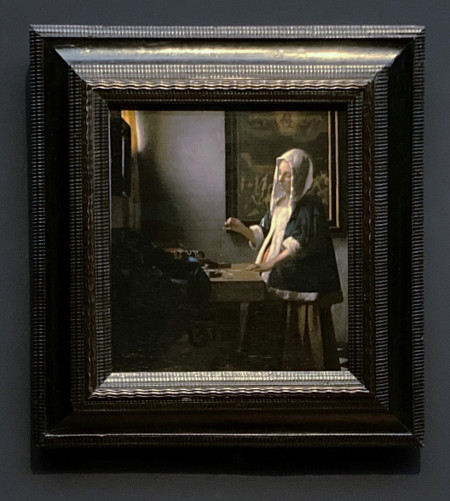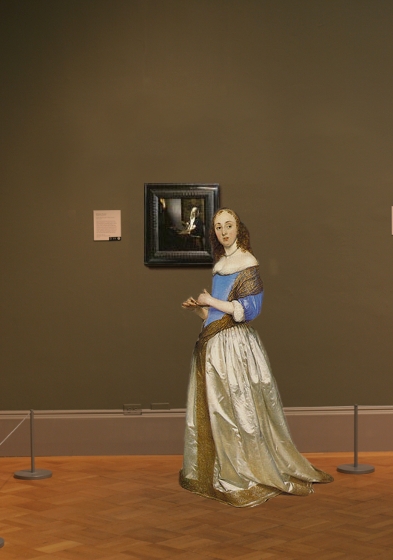Woman Holding a Balance
(Vrouw met weegschaal)c. 1662–1665
Oil on canvas, 42.5 x 38 cm. (16 3/4 x 15 in.)
National Gallery of Art, Washington D.C.
acc. no. 1942.9.97

The textual material contained in the Essential Vermeer Interactive Catalogue would fill a hefty-sized book, and is enhanced by more than 1,000 corollary images. In order to use the catalogue most advantageously:
1. Scroll your mouse over the painting to a point of particular interest. Relative information and images will slide into the box located to the right of the painting. To fix and scroll the slide-in information, single click on area of interest. To release the slide-in information, single-click the "dismiss" buttton and continue exploring.
2. To access Special Topics and Fact Sheet information and accessory images, single-click any list item. To release slide-in information, click on any list item and continue exploring.
The "picture-within-a-picture" in the background

The Last Judgment (center panel)
Jacob de Backer
c. 1580
Oil on panel, 140 x 105 cm.
O.-L. Vrouwekathedraal, Antwerp
The so-called picture-within-a-picture that appears on the back wall portrays the Last Judgment. The artist has remained an enigma, and no exact prototype for this composition has been advanced. One possibility—suggested by Pieter J. J. van Thiel—is Jacob de Backer, a late 16th-century Flemish painter and student of Frans Floris, an artist who specialized in similar Last Judgment scenes. One peculiar characteristic of this composition, often found in De Backer's works, is the image of Christ with both arms raised. Vermeer probably owned this painting or at least had it as part of his stock as an art dealer.
The mirror

Prudence
From Iconologia Cesare Ripa
Mirrors appear four times in Vermeer's limited oeuvre. A smaller one hangs in the same position on the side wall as in Woman with a Pearl Necklace.
Both frames were presumably made out of ebony, although Dutch artisans excelled in producing imitations of precious imported woods. In 17th-century Netherlands, mirror-making was a complex, labor-intensive process that involved multiple steps and a variety of craftsmen. Initially, sheets of glass were produced through blowing or casting methods, followed by flattening and annealing to make them durable and free of imperfections. The glass was then meticulously polished to achieve a smooth surface, essential for its reflective quality. A tin-mercury amalgam served as the reflective coating, which was then sealed for protection. Finally, the mirror was framed, often ornately, reflecting the high level of Dutch craftsmanship in woodworking. Given the skill and labor required, mirrors were considered luxury items and were often traded internationally, especially through Amsterdam's bustling port.
Mirrors have been represented in a great number of Western works of art throughout history. Their iconographic associations are numerous and frequently contradictory, ranging from the sense of sight to indications of pride and vanity. The mirror can also act as a complex narrative device. It may serve to extend the space of a painting, show a reflected scene that the viewer cannot otherwise see, or even include the viewer in its reflection, thus making the audience part of the work. These techniques could be employed to provoke deeper thought, engagement or moral reflection.

Girl with a Mirror, an Allegory of Profane Love
Love
Paulus Moreelse
1627
Oil on canvas, 105.5 x 83 cm.
Fitzwilliam Museum, Cambridge
Some scholars believe that the mirror might, in fact, identify the present picture as a Vanitas. However, most modern scholars, including Edward Snow and Albert Blankert, point out that the pervasive serenity of the painting is more in keeping with positive metaphorical associations traditionally connected with the mirror: self-knowledge and truth. In accordance with Christian teachings, the act of looking into a mirror could signify a spiritual endeavor to understand one's own soul. This is closely aligned with the concept of kennen, or inner knowing, a subject often explored in Dutch literature and philosophy of the time.
In his Iconologia, Cesare Ripa wrote that a mirror is one of the attributes of Prudence; with it, the woman achieves self-knowledge. Just as a mirror reflects reality, so does man achieve understanding when he comprehends the true character of the physical world. Otto van Veen related the elements of truth and love to a mirror's reflection in his emblem "Cleer and Pure." Vermeer certainly knew Ripa's Iconologia, because two of his allegorical paintings were composed with its aid.
The yellow curtain
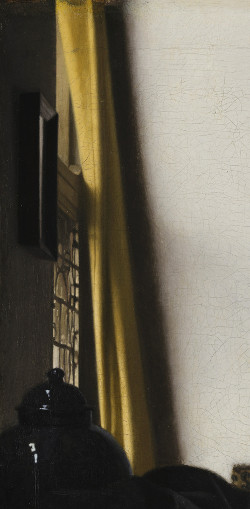
Woman with a Pearl Necklace (detail)
Johannes Vermeer
c. 1662–1665
Oil on canvas, 55 x 45 cm.
Staatliche Museen Preußischer
Kulturbesitz, Gemäldegalerie, Berlin
This curtain appears to be similar but slightly warmer in tone than the one in Woman with a Pearl Necklace (detail left). Its vibrant, warm tone is echoed by the two gilt stripes of the Last Judgment's frame, setting off the deep blues that predominate the composition.
The young lady's white cap
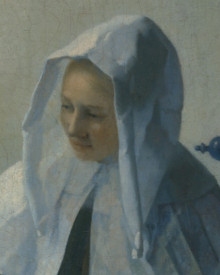
Young Woman with a Water Pitcher (detail)
Johannes Vermeer
c. 1662–1665
Oil on canvas, 45.7 x 40.6 cm.
Metropolitan Museum of Art, New York
The same white cap that is pictured in Woman Holding a Balance was represented in other paintings by Vermeer (see detail left) and in many genre paintings of the time, both tied and open. The Dutch costume expert Marieke de Winkel explains that it was partly ornamental and served to protect the hairdo before and after dressing.
In the inventory of Vermeer's wife, Catharina Bolnes, three such caps were listed (drye witte kappen), although it was also called a hooftdoek in Delft.
The fur-trimmed morning jacket

A lady at her Toilet
Gerrit ter Borch
?
Oil on panel, 46.7 x 34.9 cm.)
Private collection
This elegant jacket was typically worn by middle- and upper-class women to protect them as they performed household chores against the cold during the long Dutch winters. Houses were warmed only by a fireplace in the living room and kitchen. Its loose fit permitted freedom of movement. Dutch costume expert Marieke de Winkel explains that these jackets were worn by women at home on weekdays, already at an earlier date than that of the present painting, and are still mentioned in inventories in the 18th century. Before the 1650s and after the 1660s, however, they were no longer depicted in art.
These jackets were frequently lined with fur but sometimes only edged. Occasionally, the fur lining was detachable so it could be taken out in the summer. It was customary to store away fur garments in May. Inventories do mention unlined jackets for use during the summer months. A popular misconception regarding the jacket is that the white fur trim was ermine. De Winkel points out that even in the inventories of the wealthiest women, this particular fur is never mentioned. It must have been lined with white squirrel, mouse or cat. The jackets were called jack or jak in Amsterdam but manteltge (small mantle) in Delft.
The same jacket, which is probably the identical to the one possessed by Vermeer's wife, Catharina Bolnes, in 1675, is pictured in Vermeer's Concert and, most likely, in Girl with a Flute.
The ochre petticoat
A comparable kind of yellow garment is worn by the seated mistress in Vermeer's Mistress and Maid. The garment of the Frick painting can be traced without interruption from the illuminated triangle of the opening of the jacket to underneath the lower band of fur trim immersed in deep shadow, proving that it is a single garment. The red ribbon is not braiding because, at that time, braiding would reach to the lower edge of the skirt. The garment was always closed at the front and tied with two strings. This also explains why the two strings stand apart slightly and then overlap. This would be very strange for stitched-on braids.
The red latches must have been painted with vermilion, the strongest red pigment of the time.
The blue tablecloth
The deep blue tablecloth rucked up on the extendable oak table bears a strong resemblance in fold, color and position to the one seen in Vermeer's Woman with a Pearl Necklace, a painting that shares significant compositional similarities with Woman Holding a Balance.
The blue tablecloth forms a substantial, simple mass that reinforces the structure of the composition while simultaneously obscuring some of the excessive tiles that would have been visible beneath the tabletop. Its supple folds imply that it is made from a quite pliable material, making it improbable that the cloth could support its own weight to create the bulging mass to the left without being supported by some kind of object underneath. The elegant contour of its lower edge may serve to guide the viewer's eye upwards to the figure, while its cascading folds near the jewelry box seem to resonate with the undulating patterns of the jewelry spilling over the edge of the box.
Its rich blue hue eloquently complements the similar yet distinct color of the woman's fur-trimmed jacket. Prior to the painting's recent restoration, the tablecloth appeared greenish due to the thick yellow varnish that covered the entire work of art. Blue is particularly susceptible to discoloration from varnish. The sinuous folds of the cloth offer a contrast to the painting's geometric framework. Laboratory tests indicate that Vermeer used charcoal black and natural ultramarine blue to achieve this shade.
The still life on the table
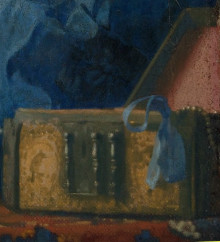
Young Woman with a Water Pitcher (detail)
Johannes Vermeer
c. 1662–1665
Oil on canvas, 45.7 x 40.6 cm.
Metropolitan Museum of Art, New York
Three different types of containers rest open on the table before the young woman. The largest of these, a jewelry box, bears a strong resemblance to those featured in two other Vermeer paintings from the same period. The red velvet lining of its opened lid echoes that of Woman with a Water Pitcher.
A gold chain, which appears only once in Vermeer's oeuvre, drapes over the lid of the box near a pearl necklace. According to Arthur K. Wheelock Jr., "These elements belong to, and are valued within, the temporal world. They are, in a sense, temptations toward material splendor. One should be hesitant to identify the woman, however, as the personification of Vanitas. Pearls have many symbolic meanings, ranging from the purity of the Virgin Mary to the vices of pride and arrogance. The woman, moreover, does not appear tempted by the jewels. She concentrates on the balance in her hand. Her attitude is one of inner peace and serenity. There is no psychological tension that would suggest a conflict between her action and the implications of the Last Judgment."
In the 17th century, jewelry boxes, also called "caskets" or "coffers," were status symbols showcasing wealth and artistic taste. Made mainly from wood, they were adorned with materials like tortoiseshell, ebony and other precious metals. The interiors were lined with luxurious fabrics. Besides jewelry, they were used to store letters and keepsakes, usually secured with locks. These boxes were not just functional but valued heirlooms, often detailed in wills, representing a family's heritage and affluence.
The massive extendable table
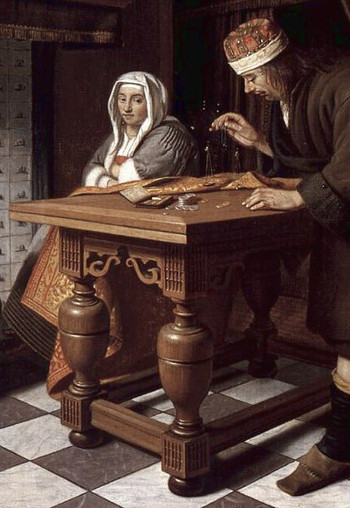
A Man Weighing Gold (detail)
Cornelis de Man
c. 1670
Oil on canvas, 81.8 x 67.6 cm.
Private collection
The balpoot extendable table featured in the present work appears various times in Vermeer's interiors and is frequently depicted in Dutch paintings of the period. Such a table would have been considered a luxury item. One example is clearly portrayed in A Man Weighing Gold (circa 1670) by Cornelis de Mann.
The term "balpoot" refers to a specific design feature found in Dutch furniture. The word translates from Dutch to "ball foot," accurately describing the bulbous, spherical shape at the bottom of the table legs. This design element gained significant popularity during the Dutch Golden Age, and was influenced partly by the Baroque movement, which emphasized ornate details and grandeur. The ball-foot design can also be found on other pieces of furniture from the period, such as cabinets or chairs.
The Rijksmuseum owns a table similar in design. The frame beneath the tabletop is adorned with volutes. Beneath this, the legs are connected by a double Y-frame stretcher. The table has a thin veneer of rosewood cemented to its oak structure, and portions of it are embellished with ebony. The table measures 78.5 x 125 x 84 cm.
Tables were a significant investment in the 17th century. Many families had to make do with makeshift tables, often constructed from a few wooden planks set on two barrels.
Since Vermeer painted a virtually identical, classical ball-leg table with a double leaf and ebony decorations in five of his paintings, it's tempting to assume that he used his own table as a model.
In the 17th-century Netherlands, the production of wooden furniture was an important craft, reflective of the country's increasing wealth and the bourgeois culture's desire for luxurious yet functional items. The artisans responsible for creating these pieces were known as meubelmakers or schrijnwerkers.
The term meubelmakers can be translated to "furniture maker," while schrijnwerkers can be loosely translated as "joiner" or "cabinetmaker." These craftsmen specialized in working with wood, creating everything from intricate cabinetry to chairs and tables. Different crafts had different wage scales. For instance, a master painter might earn more than a master carpenter due to the perceived value of their work and the demand for their skills. However, a highly skilled carpenter working on intricate projects might earn more than an average painter.
The coins on the table

For a long time, each district of the United Provinces had its own system of weights and measures. To prevent fraud, it was essential to maintain a constant check on not only the quantity of goods but also the coins. Weighing coins prevented dishonest merchants from shaving the edges of the coins to pocket extra money.
During an era when the actual value of a coin was determined by its material content rather than its face value, weighing coins was necessary for accurately assessing their real worth. Money scales in the Netherlands followed a standard form, featuring two pans. One rounded pan held a brass weight corresponding to the coin's denomination, and a triangular pan held the coin itself. A box contained the weights, the balance, and the maker's name. The government regulated money scale manufacturers and, to further encourage accurate weighing, many of the boxes bore biblical passages from Deuteronomy and Leviticus emphasizing just measurement.
Microscopic examination of the scales in Vermeer's painting has resolved one of the principal debates surrounding the painting: the woman is not weighing gold, as was initially suggested by the first description of the painting in the catalog of the Jacob Dissius auction in 1696. What had been interpreted for a long time as glints of gold are actually yellowish highlights on the forward edges of the scales' two pans. Accordingly, Vermeer expert Arthur K. Wheelock Jr. contends that the young woman is waiting for the two pans of the scale to come into balance. Conversely, Walter Liedtke posits that the absence of anything on the scale does not negate the evidence of the gold coins on the table corner, near the stack of weights. Liedtke insists that it's evident she is about to weigh gold. Nevertheless, both agree that the central message of the painting is that one should lead a life of temperance and balanced judgment. This claim is supported by stylistic evidence as well. Both the geometrical center and the vanishing point of the painting lie very close to the woman's outstretched hand, directing the viewer's attention to the balancing scales.
The small container on the table
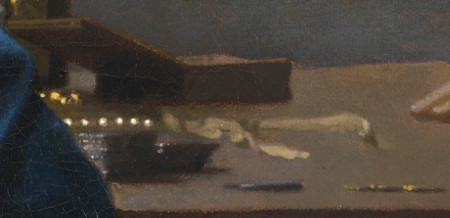
On the table lies a pearl necklace, an open jewelry box, another pearl necklace, assorted gold and silver coins and a smaller box that opens toward the young woman. This small box likely held the balance and the weights.
During the 17th century, the Netherlands emerged as a global trading powerhouse. With this surge in trade and commerce, accuracy in transactions became paramount. This gave rise to the widespread use of coin-weight boxes, known as muntgewichtdoosjes. These elegantly designed boxes, often crafted from wood or metal, encapsulated both the practicality and luxury of the age. The boxes weren't mere storage for weights; they were often intricately decorated and held weights, made primarily of brass or bronze, each corresponding to specific coinage in circulation.
For merchants, moneychangers, and even the affluent households of the time, these boxes became indispensable tools, ensuring the coins they received met the expected standards. Beyond their functional use, many coin-weight boxes also came with inscriptions or accompanying papers that detailed information about various coin types, their respective weight standards, and metal content. This feature transformed them from simple weighing tools to educational resources, particularly useful in a region bustling with various national and foreign coins.
Arthur K. Wheelock Jr. noted that personifications of conscience appeared as engraved labels on coin-weight boxes. In one example, the figure of conscience is a woman holding scales and a flaming heart. According to Wheelock, the balanced scales symbolize the internal workings of one's conscience and the moral decisions made by individuals that will eventually be weighed in heaven. A third, very small box, with its lid detached and lying to the right, may have contained the coins situated near the edge of the table. There are four coins: one silver and three gold. Oddly, the upper surfaces of the coins are scarcely visible and seem incorrect from a perspective standpoint.
The shadow cast on the background wall

The Dance of the Shadow
Samuel van Hoogstraten
Engraving
From Inleyding tot de Hooge Schoole der Schilderkonst
Rotterdam, 1675
For such a demanding painter as Vermeer, the process of harmonizing the two- and three-dimensional order of his pictures must have required days of experimentation and fine-tuning. To complicate matters, light is as much a compositional determinant as the objects on which it falls. Shadows, especially cast shadows, may become "objects" in themselves which can spoil compositional balance, occlude or destroy the sense of form altogether. This is because while real shadows are immaterial, and as such go unnoticed in normal living, painted shadows enter into competition with real objects because they are made of the same substance. Nonethless, use of the cast shadow by skilled artists helps in not only creating a sense of volume and three-dimensionality but also in establishing the relationship between objects, the viewer, and the implied source of light. Beyond realism, cast shadows have often been used symbolically in paintings. They can hint at the presence of something just outside the viewer's sight, suggest the time of day. Shadows can be elongated to create a sense of melancholy or foreboding, or they can be soft and diffuse, bringing in a gentle, dreamy mood.
If manipulated creatively, the shapes of shadows may establish meaningful compositional intervals and energize a static layout, and in this Vermeer was masterful.
Although the tones and colors of the cast shadows in Vermeer's painting are meticulously described, he must have been aware of their expressive potential as well. In his influential manual for painters, Inleyding tot de Hooge Schoole der Schilderkonst, Samuel van Hoogstraten dedicated an entire chapter to the study of shadows. With a revealing engraving, he illustrates the expressive power of the menacing shadows cast onto a wall by a group of tiny figures to the lower right. Evidently, Vermeer manipulated the cast shadows more subtly than in van Hoogstraten's engraving, in line with his overarching naturalistic goals.
Nonetheless, of all the cast shadows in Vermeer's oeuvre, this one is among the most evocative. For a moment, the otherwise austere master of geometrical order seems to have nodded to the twist and torment of the Baroque.
special topics
fact sheet
- Signature
- Date
- Provenance
- Exhibitions
- Technical description
- The 1994 restoration of the painting
- Images of the painting before and after its restauration
- The painting with its frame
- How big is this picture?
- Download High-Resolution Image from National Gallery of Art
- Google Art Project Super-zoom image
- Historic timeline of the year(s) Vermeer created this painting
- Related artworks
Critical assessment
Woman with a Balance provides us not with a warning but with comfort and reassurance; it makes us feel not vanity of life but its preciousness. Against the violent Baroque agitation of the painting behind her, the woman asserts a quiet, imperturbable calm, the quintessence of Vermeer's vision.
Edward A. Snow, A Study of Vermeer, 1979
The signature
No signature appears on this work.
(Click here to access a complete study of Vermeer's signatures.)
Dates
1662–1665
Albert Blankert, Vermeer: 1632–1675, 1975
c. 1664
Arthur K. Wheelock Jr., The Public and the Private in the Age of Vermeer, London, 2000
c. 1663–1664
Walter Liedtke, Vermeer: The Complete Paintings, New York, 2008
c. 1664
Wayne Franits, Vermeer, 2015
(Click here to access a complete study of the dates of Vermeer's paintings).
Technical report
The support is a fine, plain-weave linen with a thread count of 20 x 16 per cm². The original tacking edges are present. The canvas has been glue lined.
The ground is a warm buff color containing chalk, lead white, black and an earth pigment.
The layer structure of the paint is varied, creating different effects and textures, from thick impasto to thin glazes and scumbles. The edges of forms are rarely hard, but overlap only slightly or do not quite touch, allowing the ground to show through. Almost all areas were painted wet-in-wet. In selected areas of the painting, especially in the blue jacket, a dark, reddish-brown undermodeling is visible, particularly the shaded folds. A gray-green underpaint is found in many shadowed areas. The vanishing point of the composition is visible as a small, white spot on the x-radiograph, to the left of the hand holding the balance. The balance was enlarged, as can be seen in the infrared reflectogram. The ground and paint are in a good state of preservation.
Small losses are found in the figure, small areas of abrasion in the dark passages. Discolored inpainting and varnish were removed in 1994. During this treatment, black overpaint covering the frame of the Last Judgment on the wall behind the woman was removed, revealing two vertical bands of yellow paint along the right side of the frame, which visually link with the yellow curtain and the yellow accents on the woman's costume, thereby restoring Vermeer's original, and more dynamic, compositional intent. The conservators completed their work by replacing the existing frame with one from the same period as the painting. Overpaint that had been applied along the opened-out tacking margins when the painting was restretched on a larger stretcher has been removed. The painted image, now smaller, reflects Vermeer’s original intention.
*Johannes Vermeer (exh. cat., National Gallery of Art and Royal Cabinet of Paintings Mauritshuis - Washington and The Hague, 1995, edited by Arthur K. Wheelock Jr.)
Provenance
- (?) Pieter Claesz. van Ruijven, Delft (d. 1674); (?) his widow, Maria de Knuijt, Delft (d. 1681);
- (?) their daughter, Magdalena van Ruijven, Delft (d. 1682);
- (?) her widower, Jacob Abrahamsz Dissius (d. 1695);
- Dissius sale, Amsterdam, 16 May, 1696, no. 1;
- Isaac Rooleeuw, Amsterdam (1696–1701); Rooleeuw sale, Amsterdam 20 April, 1701, no. 6;
- Paulo van Uchelen, Amsterdam (1701–d.1702);
- Paulo van Uchelen the Younger; Amsterdam (1703–1754);
- Anna Gertruijda van Uchelen, Amsterdam (1754–d.1766);
- Van Uchelen sale, Amsterdam, 18 March, 1767, no. 6, to Kok;
- Nicolaas Nieuhoff sale, Amsterdam, 14 April, 1777, no. 116, to Van den Boogaerd;
- Trochel et al. sale, Amsterdam, 11 May, 1801, no. 48, to Van der Schley;
- King Maximilian I Jozef, Nymphenburg (before 1825);
- King of Bavaria sale, Munich, 5 December, 1826, no. 101 [as by Metsu], to Caraman;
- Victor-Louis-Charles de Riquet, duc de Caraman, Paris (1826–1830);
- Caraman sale, Paris, 10 May, 1830, no. 68;
- Casimir Périer, Paris (1830–1832); Périer heirs, Paris (1832–1848);
- Périer sale, London (Christie's), 5 May, 1848, no. 7, [bought in];
- Auguste Casimir Victor Laurent Périer, Paris (1848–1876);
- Jean Paul Pierre Casimir Périer, Paris (1876–1907);
- comtesse de Ségur-Périer, Paris (1907–1911);
- [Colnaghi, London, and Knoedler, New York, 1911];
- Peter A.B. Widener, Lynnewood Hall, Elkins Park, Philadelphia (1911–1915);
- Joseph E. Widener, Lynnewood Hall, Elkins Park, Philadelphia (1915–d.1942);
- since 1942 National Gallery of Art, Washington, DC, Widener bequest (acc. no. 1942.9.97).
Exhibitions
- New York 1912
Exhibition of Old Masters for the Benefit of The Artists' Funds and Artists' Aid Societies
M. Knoedler & Co
53, no. 49. - Detroit 1925
A Loan Exhibition of Dutch Paintings
Institute of Arts
no. 33 and ill. - Chicago 1933
A Century of Progress Exhibition of Paintings and Sculpture
Art Institute of Chicago
13, no. 80, as "A Woman Weighing Gold," lent by Mr. Joseph Widener - Philadelphia 1984
Masters of Seventeenth-Century Dutch Genre Painting
Philadelphia Museum of Art
342–343, no. 118 and ill. - Berlin 1984
Masters of Seventeenth-Century Dutch Genre Painting
Gemäldegalerie, Staatliche Museen Preussischer Kulturbesitz
no. 118 - London September 7–November 18, 1984
Masters of Seventeenth-Century Dutch Genre Painting
Royal Academy of Arts
no. 118 - Washington D.C. 1995–1996
Dutch Cabinet Galleries
National Gallery of Art
no catalogue - Washington D.C November 12, 1995–February 11, 1996
Johannes Vermeer
National Gallery of Art
140–145, no. 10 and ill. - The Hague March 1–June 2, 1996
Johannes Vermeer
Mauritshuis
140–145, no. 10 and ill. - Washington D.C May 17–August 9, 1998
A Collector's Cabinet
National Gallery of Art
no. 61, fig. 14. - Washington D.C. November 24, 1999–February 6, 2000
Johannes Vermeer: The Art of Painting
National Gallery of Art
brochure, fig. 9 - Osaka April 4–July 2, 2000
The Public and the Private in the Age of Vermeer
Municipal Museum of Art
182–185, no. 33 and ill. - New York March 8–May 27, 2001
Vermeer and the Delft School
The Metropolitan Museum of Art
no. 73 and ill., as "Woman with a Balance" - London June 20–September 16, 2001
Vermeer and the Delft School
National Gallery
no. 73 and ill., as "Woman with a Balance" - Madrid February 19–May 18, 2003
Vermeer y el interior holandés
Museo Nacional del Prado
172–173, no. 35 and ill. - Amsterdam March 11–June 1, 2009
Woman Holding a Balance
Rijksmuseum
no catalogue - Munich March 17–June 19, 2011
Vermeer in Munich: King Max I Joseph of Bavaria as a Collector of Old Masters
Alte Pinakothek
no. 1 and ill. - Detroit August 9–Labour Day (about), 2012
"Woman Holding a Balance"
Detroit Institue of Art - Paris February 20–May 22, 2017
Vermeer and the Masters of Genre Painting: Inspiration and Rivalry
Musée du Louvre - Dublin June 17–September 17, 2017
Vermeer and the Masters of Genre Painting: Inspiration and Rivalry
National Gallery of Ireland - Washington D.C. October 22, 2017–January 21, 2018
Vermeer and the Masters of Genre Painting: Inspiration and Rivalry
National Gallery of Art - Dresden June, 4–September 12, 2021
Vermeer: On Reflection
Gemäldegalerie Alte Meister, Dresden - Washington D. C. October 8, 2022–January 8, 2023
Vermeer's Secrets
National Gallery of Art - Amsterdam February 10– June 4, 2023
VERMEER
Rijksmuseum
no. 20 and ill.
(Click here to access a complete, sortable list of the exhibitions of Vermeer's paintings).
| Vermeer's life |
Vermeer's income in the 1660s was probably higher than in the 1670s. In the1660s, sales of paintings and especially his mother-in-law's (Maria Thins) substantial financial contributions together probably ranged from 850 to 1,500 guilders a year. A mason earned about 500 guilders. Vermeer is elected for the first time headsman of the Guild of Saint Luke in Delft at the age of 30 for a two year term. However, by this time many artists resident in Delft had left for the more prosperous Amsterdam and so his election may have had less significance than once believed. He was the youngest artist to become headmaster since the guild was organized in 1611. Many of the luxury items seen in Vermeer's interiors such as the virginal seen in The Music Lesson were economically out of reach of the artist. They may have been lent to him by affluent men of culture or clients such as Diego Duarte, a rich Antwerp banker, in whose important art collection was cited "a young lady playing a clavecin, with accessories, by Vermeer." The virginal seen in Vermeer's Music Lesson was built by Johannes Ruckers. These rare instruments were sold at about 300 guiders, about half the cost of Gerrit Dou, a Frans van Mieris. An averge Dutch house might cost 1,000 guilders. In Delft, hese instruments were owned by the official town musician Scholl. |
| Dutch painting |
Pieter Saendredam (b. 1597) dies in Haarlem. Despite its decline, Delft remained and important city of passage for artists passing from Haarlem, Utrecht and Amsterdam. It contained a number of fine art collections. Ferries parted many times a day to the nearby The Hague and Amsterdam was less than a days away on an inexpensive horse-towed barge. |
| European painting & architecture | André Le Nôtre designs park and gardens of Versailles Louis XIV begins to build palace of Versailles; he makes Charles Lebrun his chief artistic adviser. |
| Music | Composer Henry Lawes dies at London October 21 at age 66. |
| Literature | |
| Science & philosophy | |
| History |
New Amsterdam colonist John Bowne is arrested for permitting Quakers to hold meetings in his Flushing house, completed last year at what will become 37–01 Bowne Street, Queens (see Mathematician-physicist-philosopher-theologian Blaise Pascal dies at the Jansenist Port-Royal monastery in Paris August 19 at age 39. Publication of a world atlas in eleven parts by Joan Blaeu in Amsterdam. Remonstrance, 1657). Bowne is convicted of having violated Governor Peter Stuyvesant's ban on Quaker assemblies. He is jailed and banished, but when he reaches Holland and appeals to the Dutch West India Company, it acquits him of all charges, frees him, and rebukes Governor Stuyvesant, thereby establishing the right to free practice of religious worship. Blaise Pascal proposes the introduction of a public transport system in Paris. Coaches would travel along predetermined routes and take passengers for a small fee. The first coach goes into service during the following year. Founding of the Academia Leopoldina in Vienna The Royal Society receives charter from Charles II. Holland and France form an alliance against possible attack by England. |
| Vermeer's life |
In the early and mid-1660s Vermeer paints a series of extraordinary pictures of single women in the corner of a room absorbed in their activity. Even their most striking passages of observation are always subordinated to the impression made by the whole composition. A French diplomat and art connoisseur Balthasar de Monconys visits Vermeer in Delft. In his diary he notes that he was unable to see any paintings there and had to visit the house of a baker where he saw a painting with a single figure. De Monconys comes initially as a tourist, evidently unaware of Vermeer's presence. A few weeks later, he went to pay his respects in The Hague to Constantijn Huygens, an important art connoisseur and theorist of Dutch culture. De Monconys admired his art collection and described it in detail. However, one can only imagine how amazed Huygens must have been to hear that the Frenchman had been in Delft, without visiting Vermeer. It seems a reasonable assumption that Huygens urged de Monconys to meet with the Delft painter, given the Frenchman's predilection for fine art. Not long afterward, de Monconys did indeed visit with Vermeer at his house, and wrote the following account in his diary journal, which was published in 1665, the year of his death: "In Delft I saw the painter Verme(e)r who did not have any of his works: but we did see one at a baker's, for which six hundred livres had been paid, although it contained but a single figure, for which six pistoles would have been too high a price." Simply put, de Monconys thought the painting he saw was worth less than a tenth of the price mentioned. c. 1663 a son named Johannes, named after himself, is born to Vermeer. |
| Dutch painting |
Rembrandt depicts himself as a bit player in his painting The Raising of the Cross. Jan Steen paints The Drawing Lesson.
Adriaen van de Velde paints Cattle near a Building. Pieter de Hooch, who had moved away from Delft to Amsterdam to seek more patronage, returns to Delft at least once in this year. |
| European painting & architecture |
Bernini: Scala Regia, Vatican, Rome Building of Castle Nymphenburg, near Munich. Nicolas Poussin paints The Four Seasons. France's minister of finance Jean-Baptiste Colbert appoints painter Charles Le Brun director of the Gobelins, which will grow under Le Brun's direction from a small tapestry manufactory into a vast enterprise that supplies all of the royal houses. The Academy of Painting and Sculpture is reorganized, with Le Brun as its director. |
| Music |
Mar 7, Tomaso Antonio Vitali, composer, is born. Pascal: L'Equilibre des liqueurs (posth.) |
| Literature |
The Académie des inscriptions et belles-lettres (the Academy of the Humanities) is founded in Paris. John Milton marries Elizabeth Minshull. |
| Science & philosophy |
Isaac Newton discovers the binomial theorem. Physicist Otto von Guericke invents the first electric generator. It produces static electricity by applying friction against a revolving ball of sulfur, and Guericke will show in 1672 that the electricity can cause the surface of the sulfur ball to glow. |
| History |
Dutch forces hold the best pepper ports of India's Malabar Coast, giving them a virtual stranglehold on the spice trade once controlled by Portugal. A Third Navigation Act adopted by Parliament July 27 forbids English colonists to trade with other European countries. European goods bound for America must be unloaded at English ports and reshipped, even though English export duties and profits to middlemen may make prices prohibitive in America. |
| Vermeer's life |
In a death inventory of the English sculptor Jean Larson, who lived in the Hague, is listed "a head by Vermeer." Some critics believe it may have bee the Girl with a Pearl Earring. In the early to mid-1660s Vermeer refined all the qualities of his mature style. In his orderly designs, Vermeer gave new life to familiar patterns of contemporary genre painting by closely studying the subtleties of appearance. |
| Dutch painting |
Pieter de Hooch paints Young Woman Weighing Gold Jan Steen: paints The Christening Feast. Frans Hals, one of the most fashionable portraitists of his time and now in his late sixties, paints two of his most significant group portraits, the Regents and Regentesses of the Old Men's Alshouse at Haarlem. Owing to his dire poverty he will be given a small allowance by the town of Haarlem. |
| European painting & architecture |
Nicola Poussin paints Apollo and Daphne John Vanbrugh, Eng. architect and dramatist, is born. Christopher Wren: Sheldonian Theatre, Oxford. Francisco de Zurbaran, Spanish painter, dies. |
| Music |
The French horn becomes an orchestral instrument. Oratorio: Christmas Oratorio by Heinrich Schütz at Dresden. |
| Literature |
William Shakespeare - the second impression of the Third Folio, which added seven plays to the thirty-six of the First Folio and the Second: Pericles, Prince of Tyre and six works from the Shakespeare Apocrypha. Thomas Killigrew and the King's Company stage Killigrew's The Parson's Wedding with an all-female cast. Killigrew attempts a similar all-female production of his play Thomaso, though the project is never realized. |
| Science & philosophy |
Robert Hooke discovers the Great Red Spot (an extremely persistent storm) on Jupiter and uses it to determine the period of Jupiter's rotation, which is astonishingly less than ten hours despite Jupiter's great size. Giovanni Alfonso Borelli, calculates the orbit of a comet and finds that it is a parabola (not a circle, ellipse, or line as expected in various earlier theories). Descartes' Traité de l'homme et de la formation de foetus (treatise on man and the formation of the fetus), printed posthumously, describes animals as purely mechanical beings; that is, there is no "vital force" that makes animals different from other material objects. Christiaan Huygens proposes that the length of a pendulum with a period of one second should be the standard unit for length. |
| History |
Aug 29, Adriaen Pieck/Gerrit de Ferry patented a wooden firespout in Amsterdam. New Amsterdam handed over by Peter Stuyvesant to the English, who renames the city New York Amsterdam passes a regulation banning the sale of "rotten, spoiled, or defective spinach, cucumbers, and carrots, ears of corn, radishes, or other fruits [vegetables] because pride could not be taken in or from such things." Slavery is introduced into the Caribbean island of Montserrat and will not be abolished until 1834. The Black Death kills 24,000 in old Amsterdam while the English are taking Nieuw Amsterdam. The plague spreads to Brussels and throughout much of Flanders, and in December it kills two Frenchmen in London's Drury Lane. Men who put the dead into the deadcarts keep their pipes lit in the belief, now widespread, that tobacco smokers will somehow be spared. Samuel Pepys buys forks for his household, but most Englishmen continue to eat with their fingers and will continue to do so until early in the next century lest they be considered effete or, in the opinion of some clergymen, even sacrilegious. A man going out to dinner has for centuries brought his own spoon and knife, the spoon being folded into the pocket and the knife carried in a scabbard attached to the belt; more men now carry folding forks as well. The Kronenbourg Brewery founded in Alsace will continue into the 21st century to produce beer. |
| Vermeer's life | Pieter van Ruijven and his wife Maria Knuijt leave 500 guilders to Vermeer in their last will and testament. This kind of a bequest is very unusual and testifies a close relationship between Vermeer and Van Ruijven that went beyond the usual patron/painter one. It would seem that in his life-time the rich Delft burger had bought a sizable share of Vermeer's artistic output. |
| Dutch painting |
Rembrandt paints The Jewish Bride. Adriaen van Ostade paints The Physician in His Study. c. 1665 Gerrit Dou painted Woman at the Clavichord and a Self-Portrait in which he resembled Rembrandt. |
| European painting & architecture |
Bernini finishes high altar, Saint Peter's, Rome (begun 1656). Murillo: Rest on the Flight into Egypt. Nicolas Poussin, French painter, dies. Known as the founder of French Classicism, he spent most of his career in Rome which he reached at age 30 in 1624. His Greco-Romanism work includes The Death of Chione and The Abduction of the Sabine Women. Compagnie Saint-Gobain is founded by royal decree to make mirrors for France's Louis XIV. It will become Europe's largest glass-maker. Francesco Borromini completes Rome's Church of San Andrea delle Fratte. |
| Music |
Molière: Don Giovanni. Sep 22, Moliere's L'amour Medecin, premiered in Paris. |
| Literature |
Philosophical Transactions of the Royal Society begins publication. |
| Science & philosophy |
Giovanni Cassini determines rotations of Jupiter, Mars, and Venus. Peter Chamberlen, court physician to Charles 11, invents midwifery forceps Pierre de Fermat, French mathematician, dies. His equation xn + yn = zn is called Fermat's Last Theorem and remained unproven for many years. The history of its resolution and final proof by Andrew Wiles is told by Amir D. Aczel in his 1996 book Fermat's Last Theorem. Fermat's Enigma: The Epic Quest to Solve the World's Greatest Mathematical Problem by Simon Singh was published in 1997. In 1905 Paul Wolfskehl, a German mathematician, bequeathed a reward of 100,000 marks to whoever could find a proof to Fermat's "last theorem." It stumped mathematicians until 1993, when Andrew John Wiles made a breakthrough. Francis Grimaldi: Physicomathesis de lumine (posth.) explains diffraction of light. Isaac Newton experiments on gravitation; invents differential calculus. Robert Hooke's Micrographia, with illustrations of objects viewed through a microscope, is published. The book greatly influences both scientists and educated laypeople. In it, Hooke describes cells (viewed in sections of cork) for the first time. Fundamentally, it is the first book dealing with observations through a microscope, comparing light to waves in water. Mathematician Pierre de Fermat dies at Castres January 12 at age 63, having (with the late Blaise Pascal) founded the probability theory. His remains will be reburied in the family vault at Toulouse. |
| History |
English naval forces defeat a Dutch fleet off Lowestoft June 3 as a Second Anglo-Dutch war begins, 11 years after the end of the first such war. General George Monck, 1st duke of Albemarle, commands the English fleet, Charles II bestows a knighthood on Irish-born pirate Robert Holmes, 42, and promotes him to acting rear admiral, giving him command of the new third-rate battleship Defiance, but the Dutch block the entrance to the Thames in October. Feb 6, Anne Stuart, queen of England (1702–1714), is born. At least 68,000 Londoners died of the plague in this year.
The second war between England and the United Provinces breaks out. It will last until 1667 and devastate the art market. Mar 11, A new legal code was approved for the Dutch and English towns, guaranteeing religious observances unhindered. Nov 7, The London Gazette, the oldest surviving journal, is first published. Ceylon becomes important trade centre for the VOC. |
Vermeer: the inspired or inspirer?

Owing to the intimate nature of Vermeer's art, there has been a tendency to associate the figures in his paintings with members of his own family, some of whom seem to have posed more than once. The financial benefit of using family members willing to model for extended periods without compensation is evident. Some scholars specializing in Vermeer, including Arthur K. Wheelock Jr., posit that Vermeer's wife, Catharina, served as a model on more than one occasion, likely including for the painting in question. However, since there are no extant images of her, we cannot make any comparisons. The same woman may have also posed for Girl Reading a Letter at an Open Window (bottom left) and Woman in Blue Reading a Letter (top left). Catharina was a year older than her husband.
This woman, who appears slightly youthful in the earliest painting and pregnant in the other two, has the same high forehead, straight nose and widely-spaced eyes. She is the most appealing of Vermeer's models, none of whom can be characterized as conventional beauties. Their allure comes from how they are depicted in paint.
If we accept the date commonly attributed to the current painting, circa 1664, Catharina would have been about 32 years old when she modeled for Woman Holding a Balance. After suffering the loss of a child in 1660, she gave birth to her first son, Johannes, approximately three years later. In the subsequent years, she likely spent most of her time pregnant, giving Vermeer 15 children before his death in 1675. Eleven survived.
Is the woman pregnant?
Much thought has been given to whether the amply cut piece of clothing is a clear sign of the woman being pregnant. As the garment itself does not provide a clear answer, the speculation will continue, which is perhaps just what Vermeer intended. Catharina, Vermeer's wife, must have been pregnant much of the time, and although some scholars dispute the incipient maternity of several of Vermeer's women—fashions of the time give them a bulky look, they argue—it is hard not to side in this matter with Vincent van Gogh, who wrote to Emile Bernard in 1888 of what he took to be the pregnancy of the Woman in Blue Reading a Letter. The Woman Holding a Balance also appears to be with child, and The Lacemaker may also be in the same fecund condition. At the same time, it makes sense that Vermeer might wish to prevent the theme of pregnancy from overshadowing other aspects of his painting.
Marieke de Winkel, an expert on the history of costume, provides substantial evidence in her essay that the woman in the present painting is not, in fact, pregnant ("The Interpretation of Dress in Vermeer's Paintings.") According to de Winkel, pregnancy "was not a common subject in art and there are very few depictions of maternity wear. Even in religious paintings such as the Visitation, where depictions of pregnant women are required, the bodies of the Virgin and Saint Elizabeth were usually completely concealed by draperies." De Winkel further argues that "to my knowledge there are no examples of pregnant women in Dutch portraiture, an interesting fact considering that many women were painted in their first year of marriage, a time when they could have been with child." However, it should be noted that in a pendant of Marten Soolmans and Oopjen Coppit painted by Rembrandt in 1634, Oopjen appears visibly pregnant; she gave birth to her first child shortly after the painting was completed.
Arthur K. Wheelock Jr. also maintains that the young woman is not pregnant, but for a different reason. He notes that Dutch fashions of the mid-17th century seem to have encouraged a bulky silhouette. "The impression of the short jacket worn over a thickly padded skirt in Vermeer's painting in particular may create just such an impression." He adds,"Interpreting the contemporary costumes in Vermeer's paintings is complicated. In our time, it has often been claimed that the women in Woman in Blue Reading a Letter and Woman Holding a Balance, with their voluminous clothing and protruding bellies, are pregnant. Based on this presumed pregnancy, daring speculations were proposed on the 'meaning' of the Woman Holding a Balance. If she is not pregnant, these speculations are meaningless."
What does this painting mean?

The Money Lender
Gerrit Dou
1664
Oil on panel, 29 x 23 cm.
Musée du Louvre, Paris
While generally accepted as an allegory, the Woman Holding a Balance has been interpreted in various ways. Early authors assumed that the pans of the woman's balance contained gold or pearls. Consequently, the painting was referred to as either the Gold-Weigher or the Woman Weighing Pearls. In this light, the Last Judgment was seen as a warning that the woman should not be distracted by weighing earthly goods, but should focus on eternal values. Such an interpretation associates the woman with the iconographic tradition of the gold-weigher and its subsequent Vanitas connotations. Additionally, some contemporary authors speculate that the woman is pregnant, while others conclude that her costume reflects a style of dress prevalent in the early to mid-1660s. Others interpret the painting theologically, viewing the woman as a secularized image of the Virgin Mary, who, standing before the Last Judgment, assumes the role of intercessor and compassionate mother.
One scholar argues that the image of a pregnant Virgin Mary would have been understood by a Catholic viewer as an anticipation of Christ's life, his sacrifice and the eventual establishment of the Church. Arthur K. Wheelock Jr. noted that the scales are, in fact, empty and thus, she is portrayed in the act of balancing rather than weighing. According to Wheelock, who correlates the mood of profound serenity in the painting with this fact, "the essential message is that one should conduct one's life with temperance and balanced judgment. Indeed this message, with or without its explicit religious context, appears in paintings from all phases of Vermeer's career and must, therefore, represent one of his fundamental beliefs. The balance, an emblem of Justice and eventually of the final judgment; denotes the woman's responsibility to weigh and balance her own actions."
An extraordinary composition
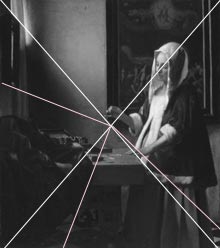
The Woman Holding a Balance is perhaps Vermeer's most successful composition. In no other work does design so effectively complement theme and the emotional setting of the painting. The pervasive yet unobtrusive geometry, the interplay of verticals and horizontals against the diagonals, mass against void and light against dark, create a balanced but dynamic composition. The geometrical center of the painting falls very near the upheld hand of the young woman. Moreover, the vanishing point of the work's perspective system, which is derived by extending the orthogonal lines of the table, mirror and floor tiles, falls very near the same point. Thus, the thematic—the act of balancing—, geometric and perspectival centers of the painting coincide, unifying its diverse realities. The composition of the Woman Holding a Balance is all the more admirable because it is achieved with such subtlety that it in no way interferes with a naturalistic reading of the painting.
"In a box"
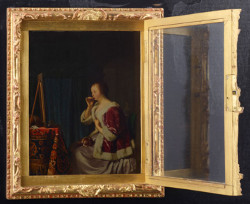
In the catalogue of the 1696 Amsterdam auction of 21 works by Vermeer describe the present work as "A young lady weighing gold, in a box (een kasje by van der Meer of Delft, extraordinarily artful and vigorously painted," which, perhaps, indicates its extraordinary value. It has been suggested that the description intended a perspective box (erroneously called a peep box or peepshow) similar to those surviving by Samuel van Hoogstraten and Carel Fabritius. However, these works display strongly distorted perspectives that allow them to function as a part of the device's illusionist purpose. Instead, Vermeer's work shows no distortion at all. The box was probably intended to shield the precious work from dust. One such box has been preserved with a painting by Vermeer's contemporary Frans van Mieris..
A very expensive painting: the 1696 Dissius sale

This work is certainly the first painting listed in the 1696 Amsterdam auction of 21 paintings by Vermeer: "A young lady weighing gold, in a box by J. van der Meer of Delft, extraordinarily artful and vigorously painted." It sold for 155 guilders, slightly less than The Milkmaid, which fetched 175 guilders. The two paintings were, and still are, considered among the finest works by the artist's hand. Even the monumental View of Delft, many times larger, fetched only 35 guilders more. The Woman Holding a Balance is the only Vermeer that can be traced back to the 17th century in an almost unbroken line.
A corner of a room

A Woman Drinking with Two Men (detail)
Pieter de Hooch
c. 1658
7Oil on canvas, 3.7 x 64.6
National Gallery, London
Because it cannot be seen, the wooden structure of the left-hand corner window represented in this painting cannot be linked with any other of Vermeer's interiors. Such windows were typically composed of four casements. The bottom two casements had shutters on the outside (see the detail of Vermeer's Little Street) and two upper shutters attached on the inside. The shutters controlled incoming light and airflow. In Vermeer's Woman Holding a Balance, it seems that only the top shutters were left open. Presumably, the window faced north.
Painters have always preferred a northern exposure for their studios, as the cooler northern light is relatively constant throughout the working day. Dutch paintings of the time predominantly represent the left side of the room. The origin of this compositional formula is complex, and is probably a blend of tradition, artistic conventions and practicality.
Early religious art, from which many traditions sprang, often portrayed light emanating from the left, possibly setting a foundational standard. As the centuries rolled on, artists might have continued this pattern, either out of respect for their artistic ancestors or sheer habit. Additionally, the natural inclination of Western viewers to scan from left to right, thanks to the direction of our written language, meant that a light source from the left could seamlessly guide the viewer's gaze across a painting. However, most importantly is the fact that an artist would favor painting with the light source coming from their left, so that the shadow projected by their own hand did not disturb their work.
A string of pearls
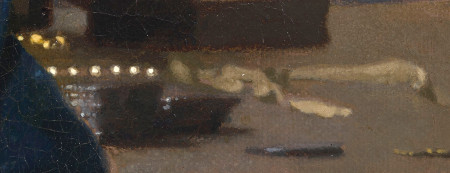
Vermeer's women are often associated with the pearls that eleven of them wear. In 1938, the painter, poet and art critic Jan Veth articulated a widespread sentiment while observing Girl with a Pearl Earring: "More than with any other Vermeer, one could say that it looks as if it were blended from the dust of crushed pearls." In the 17th century, pearls were probably an extremely important status symbol. In 1660, Samuel Pepys, an English diarist, paid 4½ pounds for a pearl necklace, and in 1666, he paid 80 pounds for another, which at the time amounted to about 45 and 800 guilders, respectively. At about the same time, the traveling French art connoisseur Balthasar de Monconys, who had been shown a single-figure painting by Vermeer, was shocked that it had been paid 600 guilders.
Listen to period music
![]() Johann Sebastian Bach
Johann Sebastian Bach
BWV 639, organ prelude to chorale Ich ruf zu dir, Herr Jesu Christ, (I call to Thee Lord Jesus Christ) [3.91 MB]
http://www.lastfm.de/music/Ton+Koopman/_/Chorale+-+%22Ich+ruf+zu+dir,+Herr+Jesu+Christ%22+BWV+639+(Studio)
Silver & gold
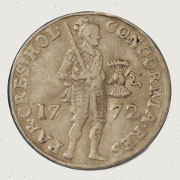
A Dutch silver ducat
Although the painting's earlier titles indicate that the woman is weighing pearls or gold, recent microscopic examination has shown that there is nothing on the pans of her scales. Thus, Vermeer has chosen to portray the moments when the scales come to balance. The only things on the table that could be weighed are coins.
Using the five coins as a starting point, historian Timothy Brook opened a window out of Vermeer's painting onto the globalization of the world. In the 17th century, coins were much softer than they are today and were also clipped by thieves. The real value of a coin was determined by the weight of its precious metal rather than its face value. Thus, a diligent household periodically weighed all its coins to establish their effective worth. Brook has conjectured that the large silver coin near the four gold coins is a ducat and not a guilder. There were various types of silver coins in circulation, but the most common was the ducat. In Europe, two silver ducats were worth one gold ducat.
Vermeer lived in a time, also known as the "silver century," when silver had become available in enormous quantities. All over the globe, business transactions were done in silver. Although the practical use of silver was confined to decorative purposes, silver had become the universal measure of wealth. The principal suppliers of silver were Japan and South America. The Chinese accumulated huge amounts of silver since they were not interested in making transactions with European goods but accepted silver payments for the porcelain, silk clothing and other exotic goods they produced and had become the rage in Europe. Furthermore, in China, one unit of gold could be bought for six units of silver instead of the twelve in Europe.
Although there were some silver mines in Germany and Austria, the great bulk of silver which reached the ports of Amsterdam and London came from Spanish mines in Peru. Much of it came from the desolate boomtown of Potosí. Founded in 1546 as a mining town, it soon produced fabulous wealth, becoming one of the largest cities in the Americas and the world with a population exceeding 200,000 people. In Spanish, there is still a saying, "valer un potosí," which means "to be worth a fortune."
"Pictures-within-pictures" in Dutch painting
Midway in the 17th century, paintings had become so prevalent in Dutch households that they became a subject matter themselves. These miniature replicas of real paintings are now referred to as pictures-within-pictures. In the last fifty years, this minor but quintessentially Dutch motif has been the object of intense scrutiny by the iconographic school of art history, which assumes that interior painters intentionally introduced pictures-within-pictures with symbolic meaning to influence the reception of the work as a whole. In regards to pictures-within-pictures in Vermeer's oeuvre, many interpretations remain a subject of debate. Amidst the dispute, however, little attention has been paid to how, in effect, Vermeer actually went about the more "mundane" chore of depicting them.
First of all, evidence suggests that Vermeer's pictures-within-pictures were copied from real works, which were either part of his mother-in-law's art collection or works with which the artist engaged to provide supplementary income. For example, a large-scale Cupid, which appeared four times in his oeuvre (painted out by the artist in the early Girl Reading a Letter at an Open Window) was listed in the upstairs back room of his house among other items including "two tapestries, a long low wicker basket with a high back, in which the mother can nurse her baby and a painting of a tronie."
The only surviving work which Vermeer inserted in his own compositions is Dirck van Baburen's Procuress (or a close copy) that can be seen in the backgrounds of The Concert and the later A Lady Seated at a Virginal. Vermeer's version is accurately represented in drawing and dimension. This example should not encourage us to believe that Vermeer unthinkingly adhered to the reality of his studio setup. The cabinet-sized Finding of Moses, in the background of The Astronomer, makes a second startling appearance in the later Woman Writing a Letter with her Maid. Whatever its original dimensions, the Cupid may have been given a virtual coat of yellow varnish to mitigate its uncensored brashness.
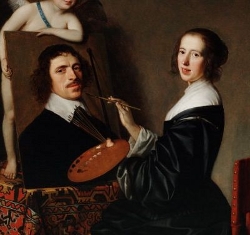
Allegory of Painting (detail)
Gerrit van Honthorst
1648
Oil on canvas, 138 x 113
Crocker Art Museum, Sacramento
When depicting pictures-within-pictures, the vast majority of Dutch painters often took a nonchalant attitude and adopted the stylistic register of the work in which they were inserted. This oversight occasionally gave rise to some rather amusing effects. For example, in a portrait by Gerrit van Honthorst, an accomplished technician, the face of the picture-within-a-picture sitting on the easel glares out at the viewer and seems no less real than that of the painter herself, with the consequence that both confusedly vie for the viewer's attention. Although Dutch painters excelled in the description of appearances, and especially textures, we have the impression that they did not fully grasp the fact that unfaltering attention to detail does not necessarily guarantee the most natural effect in all cases. While they pondered how to produce accurate portrayals of the brilliance of shiny metals or the opaque roughness of a lemon peel, it seems that the essential visual quality of a painting-with-a-painting, its flatness, had substantially escaped their attention.

On the other hand, Vermeer seems to have been well aware of the picture-within-a-picture's characterizing structural properties and experimented with various techniques to make this clear to the viewer. First of all, he drained the pictures-within-pictures of their color, painting them in dull ochres and browns. But most importantly, he obliterated continuous modeling of light and shade, a technique that would have gone against the grain of any self-respecting Dutch realist, and drastically reduced the range of chiaroscural values. The original image was decomposed into a sort of pictorial puzzle where each piece sets firmly alongside the other on the picture plane, annulling the sensations of light and depth, the raison d'être of the original work.
Silver & gold
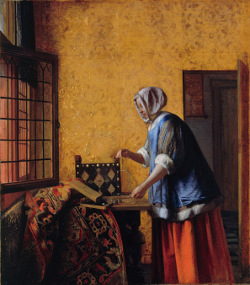
A Woman Weighing Gold
Pieter de Hooch
Oil on canvas, c. 1664
Stiftung Preussischer Kulturbesitz, Gemäldegalerie, Berlin
The origin of this work has traditionally been linked to Pieter de Hooch, whose Gold-Weigher closely resembles Vermeer's piece. Since neither of the paintings is dated, critics have hypothesized who influenced whom based on style alone. Arthur K. Wheelock Jr. cautiously attributes the original concept to De Hooch, who was at the time residing and working in Amsterdam. However, it's likely that De Hooch, who had previously lived in Delft, did not permanently relocate to the more promising Amsterdam but continued to frequent Delft, where the two painters could have presumably met, exchanged perspectives and shared examples of their current works.
Given that De Hooch's composition originally contained a second figure seated on the far side of the table, Wheelock believes, "it seems unlikely that De Hooch would have introduced the figure of the man, and then removed it, had he derived his composition from Woman Holding a Balance. De Hooch probably eliminated the second figure before Vermeer saw the painting." However, Walter Liedtke countered, "That De Hooch considered adding a seated figure in the background hardly suggests... that his composition must precede Vermeer's."
Recently, Adriaan E. Waiboer has reexamined the issue and offered compelling reasons for challenging Wheelock's stance. He writes, "The direction of influence is suggested by the fact that single-figure scenes are exceptional in De Hooch's oeuvre, not in Vermeer's. Moreover, De Hooch's painting includes an open window in the left foreground and a bundled-up tapestry on the table, two elements new to De Hooch but previously explored by Vermeer." Although Waiboer concedes that Vermeer's art did not have an influence comparable to that of the most influential Dutch artists of the time, his impact has nonetheless been underestimated. "He may not have had a large group of younger followers, but several key Dutch genre painters after 1660 responded to Vermeer's work, even if it was only once in their career. Vermeer's art enjoyed more than a fleeting moment of recognition and even served as an example for a handful of artists at the end of the century. It would take another 250 years, however, before Vermeer's impact became a global phenomenon."
The 1994 resoration of the painting
In 1994 conservators at the National Gallery cleaned the painting, removing discolored varnish from its surface. Their work revealed that at some point in the past, the painting had been extended by a half inch on all four sides. To restore it to its original size, conservators removed the added paint. Also in the past, black and grayish paint had been added, particularly on the frame of The Last Judgment. After three month's work, golden yellow highlights that originally represented the frame's gilding were uncovered. The recently revealed gold trim on the frame creates an accent in the upper right that visually links with the yellow curtain and the yellow accents on the woman's costume, thereby restoring Vermeer's original, and more dynamic, compositional intent. Compare photographs of the work before and after treatment. The conservators completed their work by replacing the existing frame with one from the same period as the painting.

